Leadership Theory in Clinical Practice
VerifiedAdded on 2023/03/17
|8
|3756
|68
AI Summary
This article explores different leadership theories and their application in clinical practice. It discusses the importance of effective clinical leadership in ensuring high-quality healthcare and provides insights on how to improve leadership effectiveness. The article also highlights the need for different leadership styles in different situations and emphasizes the importance of knowing which approach is most effective to achieve organizational goals.
Contribute Materials
Your contribution can guide someone’s learning journey. Share your
documents today.
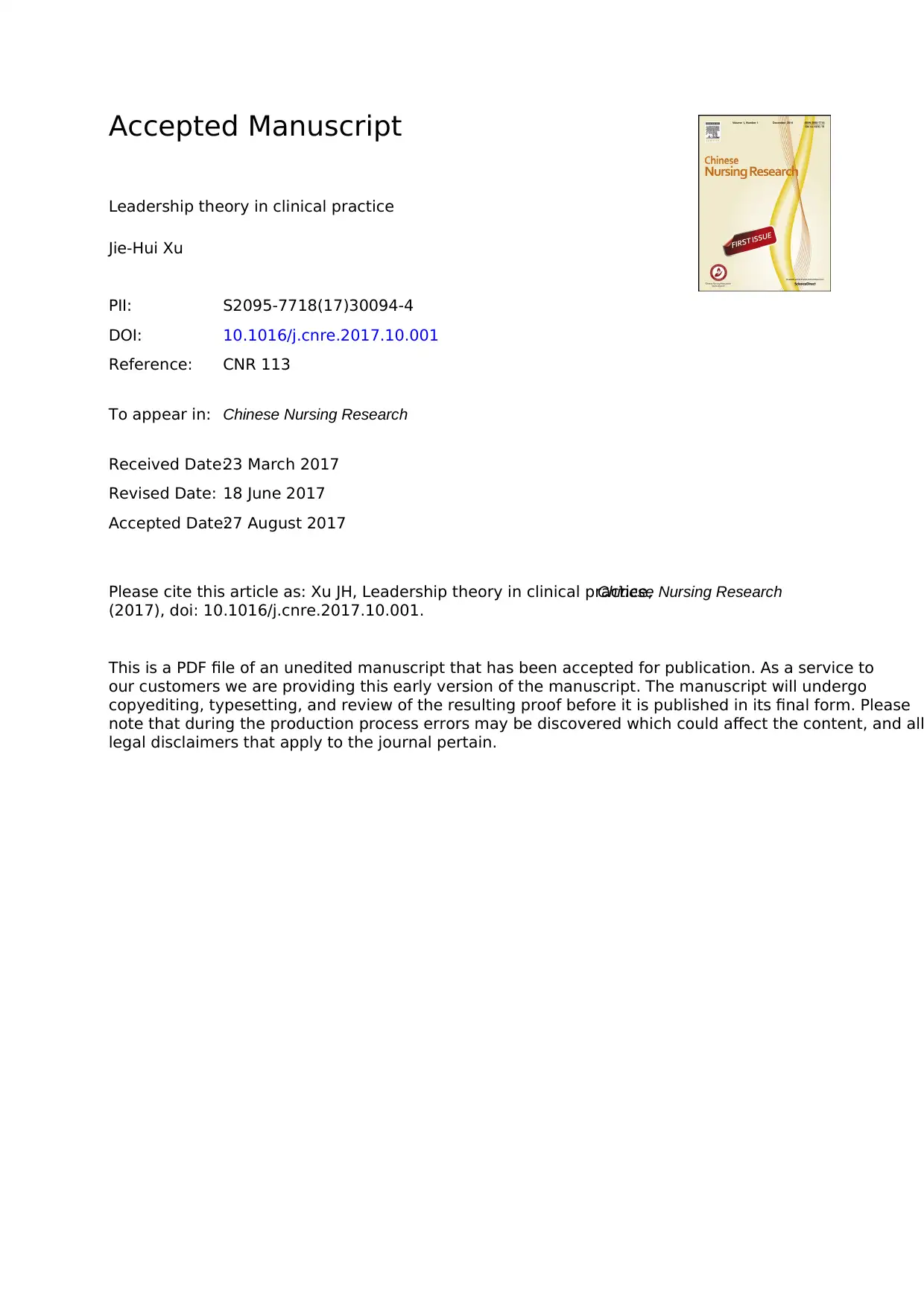
Accepted Manuscript
Leadership theory in clinical practice
Jie-Hui Xu
PII: S2095-7718(17)30094-4
DOI: 10.1016/j.cnre.2017.10.001
Reference: CNR 113
To appear in: Chinese Nursing Research
Received Date:23 March 2017
Revised Date: 18 June 2017
Accepted Date:27 August 2017
Please cite this article as: Xu JH, Leadership theory in clinical practice,Chinese Nursing Research
(2017), doi: 10.1016/j.cnre.2017.10.001.
This is a PDF file of an unedited manuscript that has been accepted for publication. As a service to
our customers we are providing this early version of the manuscript. The manuscript will undergo
copyediting, typesetting, and review of the resulting proof before it is published in its final form. Please
note that during the production process errors may be discovered which could affect the content, and all
legal disclaimers that apply to the journal pertain.
Leadership theory in clinical practice
Jie-Hui Xu
PII: S2095-7718(17)30094-4
DOI: 10.1016/j.cnre.2017.10.001
Reference: CNR 113
To appear in: Chinese Nursing Research
Received Date:23 March 2017
Revised Date: 18 June 2017
Accepted Date:27 August 2017
Please cite this article as: Xu JH, Leadership theory in clinical practice,Chinese Nursing Research
(2017), doi: 10.1016/j.cnre.2017.10.001.
This is a PDF file of an unedited manuscript that has been accepted for publication. As a service to
our customers we are providing this early version of the manuscript. The manuscript will undergo
copyediting, typesetting, and review of the resulting proof before it is published in its final form. Please
note that during the production process errors may be discovered which could affect the content, and all
legal disclaimers that apply to the journal pertain.
Secure Best Marks with AI Grader
Need help grading? Try our AI Grader for instant feedback on your assignments.
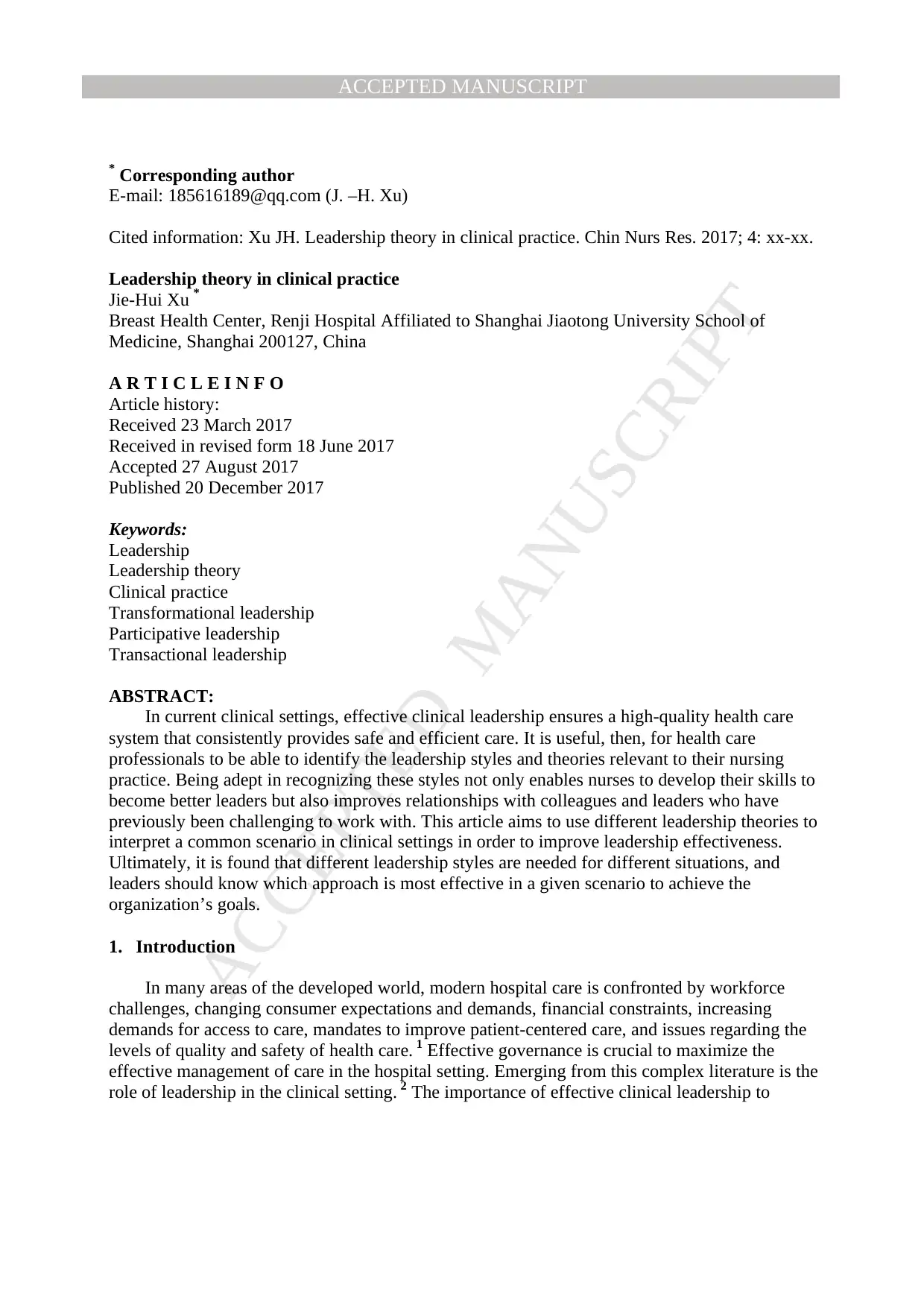
MANUSCRIPTACCEPTED
ACCEPTED MANUSCRIPT
* Corresponding author
E-mail: 185616189@qq.com (J. –H. Xu)
Cited information: Xu JH. Leadership theory in clinical practice. Chin Nurs Res. 2017; 4: xx-xx.
Leadership theory in clinical practice
Jie-Hui Xu *
Breast Health Center, Renji Hospital Affiliated to Shanghai Jiaotong University School of
Medicine, Shanghai 200127, China
A R T I C L E I N F O
Article history:
Received 23 March 2017
Received in revised form 18 June 2017
Accepted 27 August 2017
Published 20 December 2017
Keywords:
Leadership
Leadership theory
Clinical practice
Transformational leadership
Participative leadership
Transactional leadership
ABSTRACT:
In current clinical settings, effective clinical leadership ensures a high-quality health care
system that consistently provides safe and efficient care. It is useful, then, for health care
professionals to be able to identify the leadership styles and theories relevant to their nursing
practice. Being adept in recognizing these styles not only enables nurses to develop their skills to
become better leaders but also improves relationships with colleagues and leaders who have
previously been challenging to work with. This article aims to use different leadership theories to
interpret a common scenario in clinical settings in order to improve leadership effectiveness.
Ultimately, it is found that different leadership styles are needed for different situations, and
leaders should know which approach is most effective in a given scenario to achieve the
organization’s goals.
1. Introduction
In many areas of the developed world, modern hospital care is confronted by workforce
challenges, changing consumer expectations and demands, financial constraints, increasing
demands for access to care, mandates to improve patient-centered care, and issues regarding the
levels of quality and safety of health care. 1 Effective governance is crucial to maximize the
effective management of care in the hospital setting. Emerging from this complex literature is the
role of leadership in the clinical setting. 2 The importance of effective clinical leadership to
ACCEPTED MANUSCRIPT
* Corresponding author
E-mail: 185616189@qq.com (J. –H. Xu)
Cited information: Xu JH. Leadership theory in clinical practice. Chin Nurs Res. 2017; 4: xx-xx.
Leadership theory in clinical practice
Jie-Hui Xu *
Breast Health Center, Renji Hospital Affiliated to Shanghai Jiaotong University School of
Medicine, Shanghai 200127, China
A R T I C L E I N F O
Article history:
Received 23 March 2017
Received in revised form 18 June 2017
Accepted 27 August 2017
Published 20 December 2017
Keywords:
Leadership
Leadership theory
Clinical practice
Transformational leadership
Participative leadership
Transactional leadership
ABSTRACT:
In current clinical settings, effective clinical leadership ensures a high-quality health care
system that consistently provides safe and efficient care. It is useful, then, for health care
professionals to be able to identify the leadership styles and theories relevant to their nursing
practice. Being adept in recognizing these styles not only enables nurses to develop their skills to
become better leaders but also improves relationships with colleagues and leaders who have
previously been challenging to work with. This article aims to use different leadership theories to
interpret a common scenario in clinical settings in order to improve leadership effectiveness.
Ultimately, it is found that different leadership styles are needed for different situations, and
leaders should know which approach is most effective in a given scenario to achieve the
organization’s goals.
1. Introduction
In many areas of the developed world, modern hospital care is confronted by workforce
challenges, changing consumer expectations and demands, financial constraints, increasing
demands for access to care, mandates to improve patient-centered care, and issues regarding the
levels of quality and safety of health care. 1 Effective governance is crucial to maximize the
effective management of care in the hospital setting. Emerging from this complex literature is the
role of leadership in the clinical setting. 2 The importance of effective clinical leadership to
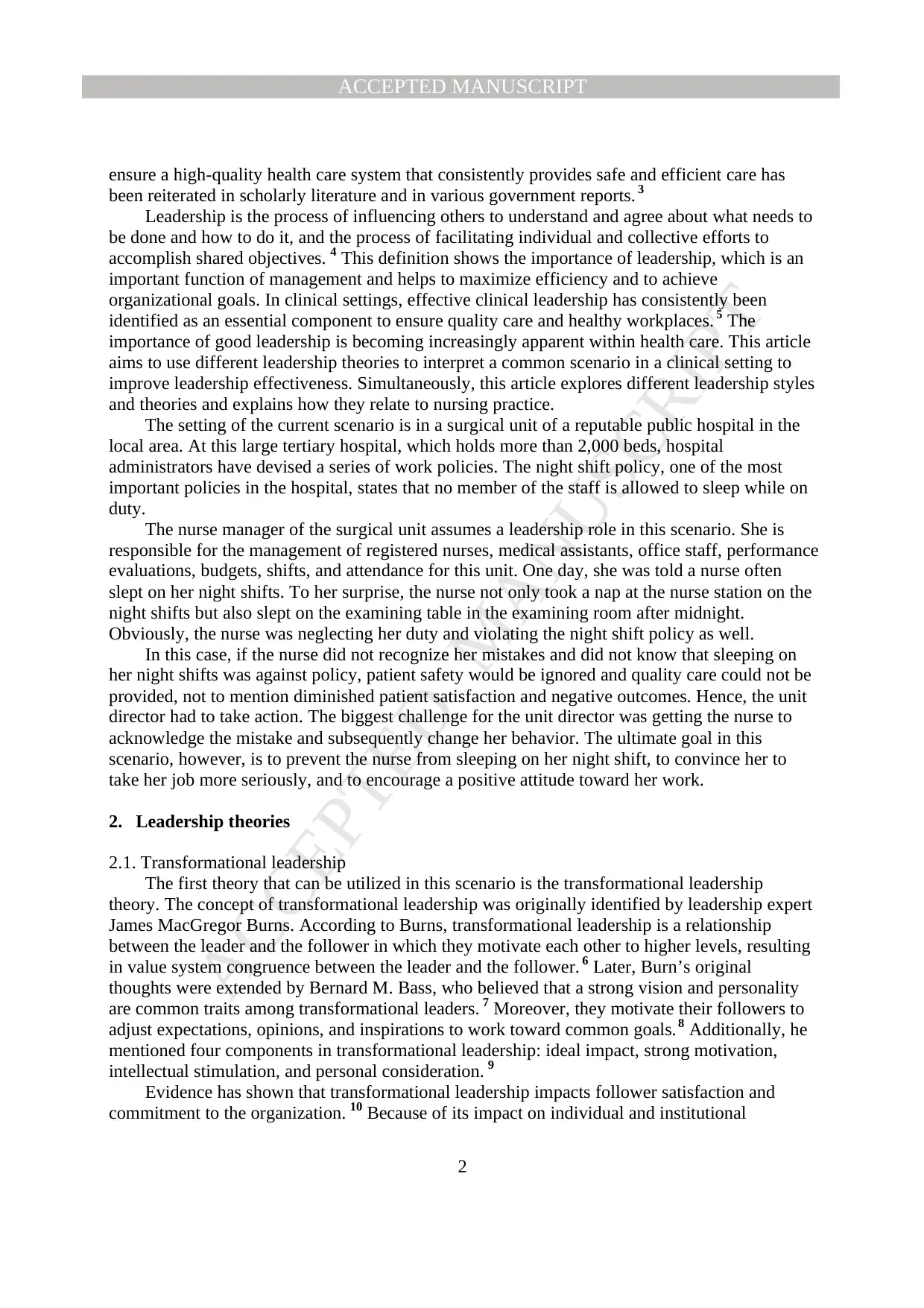
MANUSCRIPTACCEPTED
ACCEPTED MANUSCRIPT
2
ensure a high-quality health care system that consistently provides safe and efficient care has
been reiterated in scholarly literature and in various government reports. 3
Leadership is the process of influencing others to understand and agree about what needs to
be done and how to do it, and the process of facilitating individual and collective efforts to
accomplish shared objectives. 4 This definition shows the importance of leadership, which is an
important function of management and helps to maximize efficiency and to achieve
organizational goals. In clinical settings, effective clinical leadership has consistently been
identified as an essential component to ensure quality care and healthy workplaces. 5 The
importance of good leadership is becoming increasingly apparent within health care. This article
aims to use different leadership theories to interpret a common scenario in a clinical setting to
improve leadership effectiveness. Simultaneously, this article explores different leadership styles
and theories and explains how they relate to nursing practice.
The setting of the current scenario is in a surgical unit of a reputable public hospital in the
local area. At this large tertiary hospital, which holds more than 2,000 beds, hospital
administrators have devised a series of work policies. The night shift policy, one of the most
important policies in the hospital, states that no member of the staff is allowed to sleep while on
duty.
The nurse manager of the surgical unit assumes a leadership role in this scenario. She is
responsible for the management of registered nurses, medical assistants, office staff, performance
evaluations, budgets, shifts, and attendance for this unit. One day, she was told a nurse often
slept on her night shifts. To her surprise, the nurse not only took a nap at the nurse station on the
night shifts but also slept on the examining table in the examining room after midnight.
Obviously, the nurse was neglecting her duty and violating the night shift policy as well.
In this case, if the nurse did not recognize her mistakes and did not know that sleeping on
her night shifts was against policy, patient safety would be ignored and quality care could not be
provided, not to mention diminished patient satisfaction and negative outcomes. Hence, the unit
director had to take action. The biggest challenge for the unit director was getting the nurse to
acknowledge the mistake and subsequently change her behavior. The ultimate goal in this
scenario, however, is to prevent the nurse from sleeping on her night shift, to convince her to
take her job more seriously, and to encourage a positive attitude toward her work.
2. Leadership theories
2.1. Transformational leadership
The first theory that can be utilized in this scenario is the transformational leadership
theory. The concept of transformational leadership was originally identified by leadership expert
James MacGregor Burns. According to Burns, transformational leadership is a relationship
between the leader and the follower in which they motivate each other to higher levels, resulting
in value system congruence between the leader and the follower. 6 Later, Burn’s original
thoughts were extended by Bernard M. Bass, who believed that a strong vision and personality
are common traits among transformational leaders. 7 Moreover, they motivate their followers to
adjust expectations, opinions, and inspirations to work toward common goals. 8 Additionally, he
mentioned four components in transformational leadership: ideal impact, strong motivation,
intellectual stimulation, and personal consideration. 9
Evidence has shown that transformational leadership impacts follower satisfaction and
commitment to the organization. 10 Because of its impact on individual and institutional
ACCEPTED MANUSCRIPT
2
ensure a high-quality health care system that consistently provides safe and efficient care has
been reiterated in scholarly literature and in various government reports. 3
Leadership is the process of influencing others to understand and agree about what needs to
be done and how to do it, and the process of facilitating individual and collective efforts to
accomplish shared objectives. 4 This definition shows the importance of leadership, which is an
important function of management and helps to maximize efficiency and to achieve
organizational goals. In clinical settings, effective clinical leadership has consistently been
identified as an essential component to ensure quality care and healthy workplaces. 5 The
importance of good leadership is becoming increasingly apparent within health care. This article
aims to use different leadership theories to interpret a common scenario in a clinical setting to
improve leadership effectiveness. Simultaneously, this article explores different leadership styles
and theories and explains how they relate to nursing practice.
The setting of the current scenario is in a surgical unit of a reputable public hospital in the
local area. At this large tertiary hospital, which holds more than 2,000 beds, hospital
administrators have devised a series of work policies. The night shift policy, one of the most
important policies in the hospital, states that no member of the staff is allowed to sleep while on
duty.
The nurse manager of the surgical unit assumes a leadership role in this scenario. She is
responsible for the management of registered nurses, medical assistants, office staff, performance
evaluations, budgets, shifts, and attendance for this unit. One day, she was told a nurse often
slept on her night shifts. To her surprise, the nurse not only took a nap at the nurse station on the
night shifts but also slept on the examining table in the examining room after midnight.
Obviously, the nurse was neglecting her duty and violating the night shift policy as well.
In this case, if the nurse did not recognize her mistakes and did not know that sleeping on
her night shifts was against policy, patient safety would be ignored and quality care could not be
provided, not to mention diminished patient satisfaction and negative outcomes. Hence, the unit
director had to take action. The biggest challenge for the unit director was getting the nurse to
acknowledge the mistake and subsequently change her behavior. The ultimate goal in this
scenario, however, is to prevent the nurse from sleeping on her night shift, to convince her to
take her job more seriously, and to encourage a positive attitude toward her work.
2. Leadership theories
2.1. Transformational leadership
The first theory that can be utilized in this scenario is the transformational leadership
theory. The concept of transformational leadership was originally identified by leadership expert
James MacGregor Burns. According to Burns, transformational leadership is a relationship
between the leader and the follower in which they motivate each other to higher levels, resulting
in value system congruence between the leader and the follower. 6 Later, Burn’s original
thoughts were extended by Bernard M. Bass, who believed that a strong vision and personality
are common traits among transformational leaders. 7 Moreover, they motivate their followers to
adjust expectations, opinions, and inspirations to work toward common goals. 8 Additionally, he
mentioned four components in transformational leadership: ideal impact, strong motivation,
intellectual stimulation, and personal consideration. 9
Evidence has shown that transformational leadership impacts follower satisfaction and
commitment to the organization. 10 Because of its impact on individual and institutional
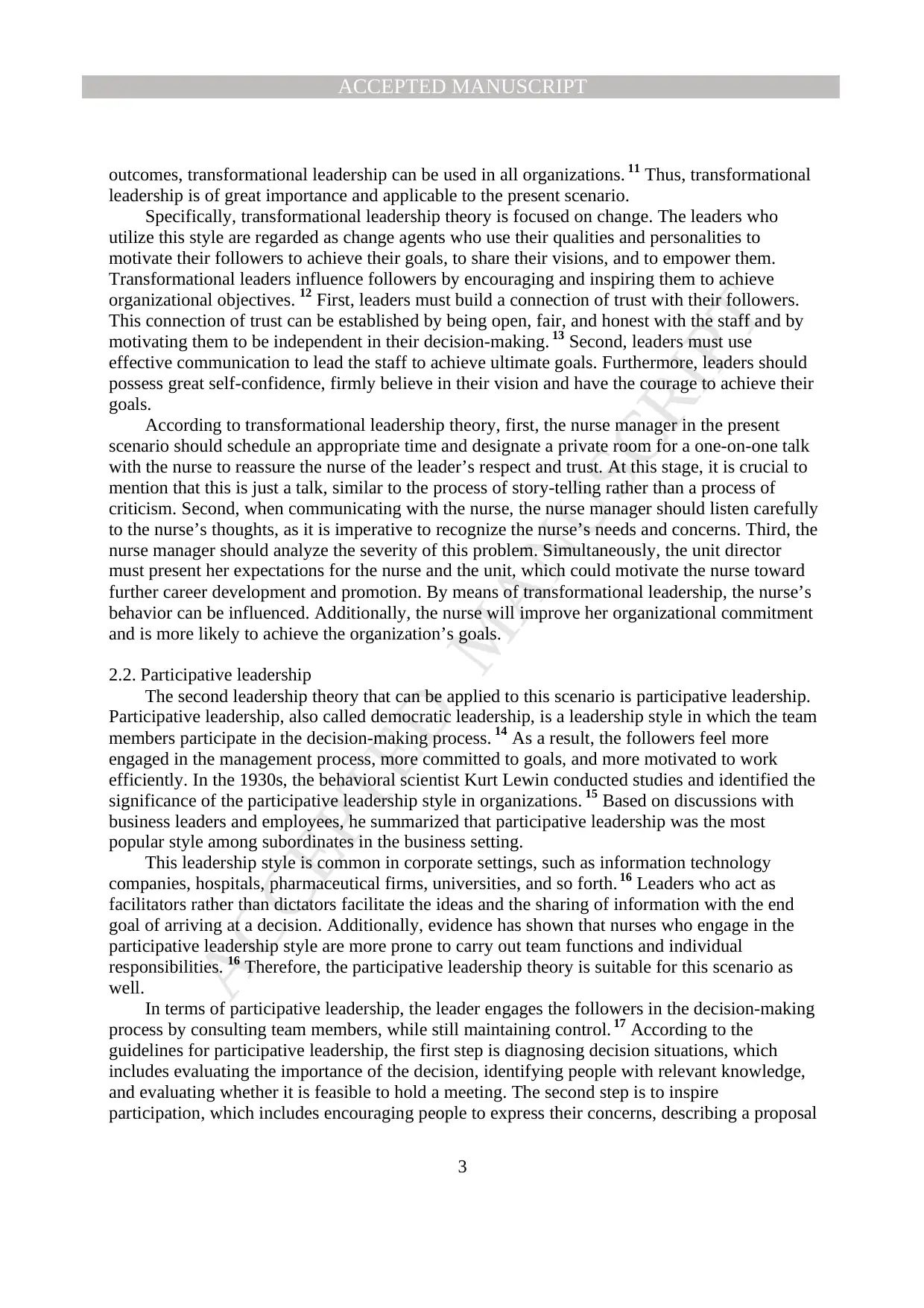
MANUSCRIPTACCEPTED
ACCEPTED MANUSCRIPT
3
outcomes, transformational leadership can be used in all organizations. 11 Thus, transformational
leadership is of great importance and applicable to the present scenario.
Specifically, transformational leadership theory is focused on change. The leaders who
utilize this style are regarded as change agents who use their qualities and personalities to
motivate their followers to achieve their goals, to share their visions, and to empower them.
Transformational leaders influence followers by encouraging and inspiring them to achieve
organizational objectives. 12 First, leaders must build a connection of trust with their followers.
This connection of trust can be established by being open, fair, and honest with the staff and by
motivating them to be independent in their decision-making. 13 Second, leaders must use
effective communication to lead the staff to achieve ultimate goals. Furthermore, leaders should
possess great self-confidence, firmly believe in their vision and have the courage to achieve their
goals.
According to transformational leadership theory, first, the nurse manager in the present
scenario should schedule an appropriate time and designate a private room for a one-on-one talk
with the nurse to reassure the nurse of the leader’s respect and trust. At this stage, it is crucial to
mention that this is just a talk, similar to the process of story-telling rather than a process of
criticism. Second, when communicating with the nurse, the nurse manager should listen carefully
to the nurse’s thoughts, as it is imperative to recognize the nurse’s needs and concerns. Third, the
nurse manager should analyze the severity of this problem. Simultaneously, the unit director
must present her expectations for the nurse and the unit, which could motivate the nurse toward
further career development and promotion. By means of transformational leadership, the nurse’s
behavior can be influenced. Additionally, the nurse will improve her organizational commitment
and is more likely to achieve the organization’s goals.
2.2. Participative leadership
The second leadership theory that can be applied to this scenario is participative leadership.
Participative leadership, also called democratic leadership, is a leadership style in which the team
members participate in the decision-making process. 14 As a result, the followers feel more
engaged in the management process, more committed to goals, and more motivated to work
efficiently. In the 1930s, the behavioral scientist Kurt Lewin conducted studies and identified the
significance of the participative leadership style in organizations. 15 Based on discussions with
business leaders and employees, he summarized that participative leadership was the most
popular style among subordinates in the business setting.
This leadership style is common in corporate settings, such as information technology
companies, hospitals, pharmaceutical firms, universities, and so forth. 16 Leaders who act as
facilitators rather than dictators facilitate the ideas and the sharing of information with the end
goal of arriving at a decision. Additionally, evidence has shown that nurses who engage in the
participative leadership style are more prone to carry out team functions and individual
responsibilities. 16 Therefore, the participative leadership theory is suitable for this scenario as
well.
In terms of participative leadership, the leader engages the followers in the decision-making
process by consulting team members, while still maintaining control. 17 According to the
guidelines for participative leadership, the first step is diagnosing decision situations, which
includes evaluating the importance of the decision, identifying people with relevant knowledge,
and evaluating whether it is feasible to hold a meeting. The second step is to inspire
participation, which includes encouraging people to express their concerns, describing a proposal
ACCEPTED MANUSCRIPT
3
outcomes, transformational leadership can be used in all organizations. 11 Thus, transformational
leadership is of great importance and applicable to the present scenario.
Specifically, transformational leadership theory is focused on change. The leaders who
utilize this style are regarded as change agents who use their qualities and personalities to
motivate their followers to achieve their goals, to share their visions, and to empower them.
Transformational leaders influence followers by encouraging and inspiring them to achieve
organizational objectives. 12 First, leaders must build a connection of trust with their followers.
This connection of trust can be established by being open, fair, and honest with the staff and by
motivating them to be independent in their decision-making. 13 Second, leaders must use
effective communication to lead the staff to achieve ultimate goals. Furthermore, leaders should
possess great self-confidence, firmly believe in their vision and have the courage to achieve their
goals.
According to transformational leadership theory, first, the nurse manager in the present
scenario should schedule an appropriate time and designate a private room for a one-on-one talk
with the nurse to reassure the nurse of the leader’s respect and trust. At this stage, it is crucial to
mention that this is just a talk, similar to the process of story-telling rather than a process of
criticism. Second, when communicating with the nurse, the nurse manager should listen carefully
to the nurse’s thoughts, as it is imperative to recognize the nurse’s needs and concerns. Third, the
nurse manager should analyze the severity of this problem. Simultaneously, the unit director
must present her expectations for the nurse and the unit, which could motivate the nurse toward
further career development and promotion. By means of transformational leadership, the nurse’s
behavior can be influenced. Additionally, the nurse will improve her organizational commitment
and is more likely to achieve the organization’s goals.
2.2. Participative leadership
The second leadership theory that can be applied to this scenario is participative leadership.
Participative leadership, also called democratic leadership, is a leadership style in which the team
members participate in the decision-making process. 14 As a result, the followers feel more
engaged in the management process, more committed to goals, and more motivated to work
efficiently. In the 1930s, the behavioral scientist Kurt Lewin conducted studies and identified the
significance of the participative leadership style in organizations. 15 Based on discussions with
business leaders and employees, he summarized that participative leadership was the most
popular style among subordinates in the business setting.
This leadership style is common in corporate settings, such as information technology
companies, hospitals, pharmaceutical firms, universities, and so forth. 16 Leaders who act as
facilitators rather than dictators facilitate the ideas and the sharing of information with the end
goal of arriving at a decision. Additionally, evidence has shown that nurses who engage in the
participative leadership style are more prone to carry out team functions and individual
responsibilities. 16 Therefore, the participative leadership theory is suitable for this scenario as
well.
In terms of participative leadership, the leader engages the followers in the decision-making
process by consulting team members, while still maintaining control. 17 According to the
guidelines for participative leadership, the first step is diagnosing decision situations, which
includes evaluating the importance of the decision, identifying people with relevant knowledge,
and evaluating whether it is feasible to hold a meeting. The second step is to inspire
participation, which includes encouraging people to express their concerns, describing a proposal
Secure Best Marks with AI Grader
Need help grading? Try our AI Grader for instant feedback on your assignments.
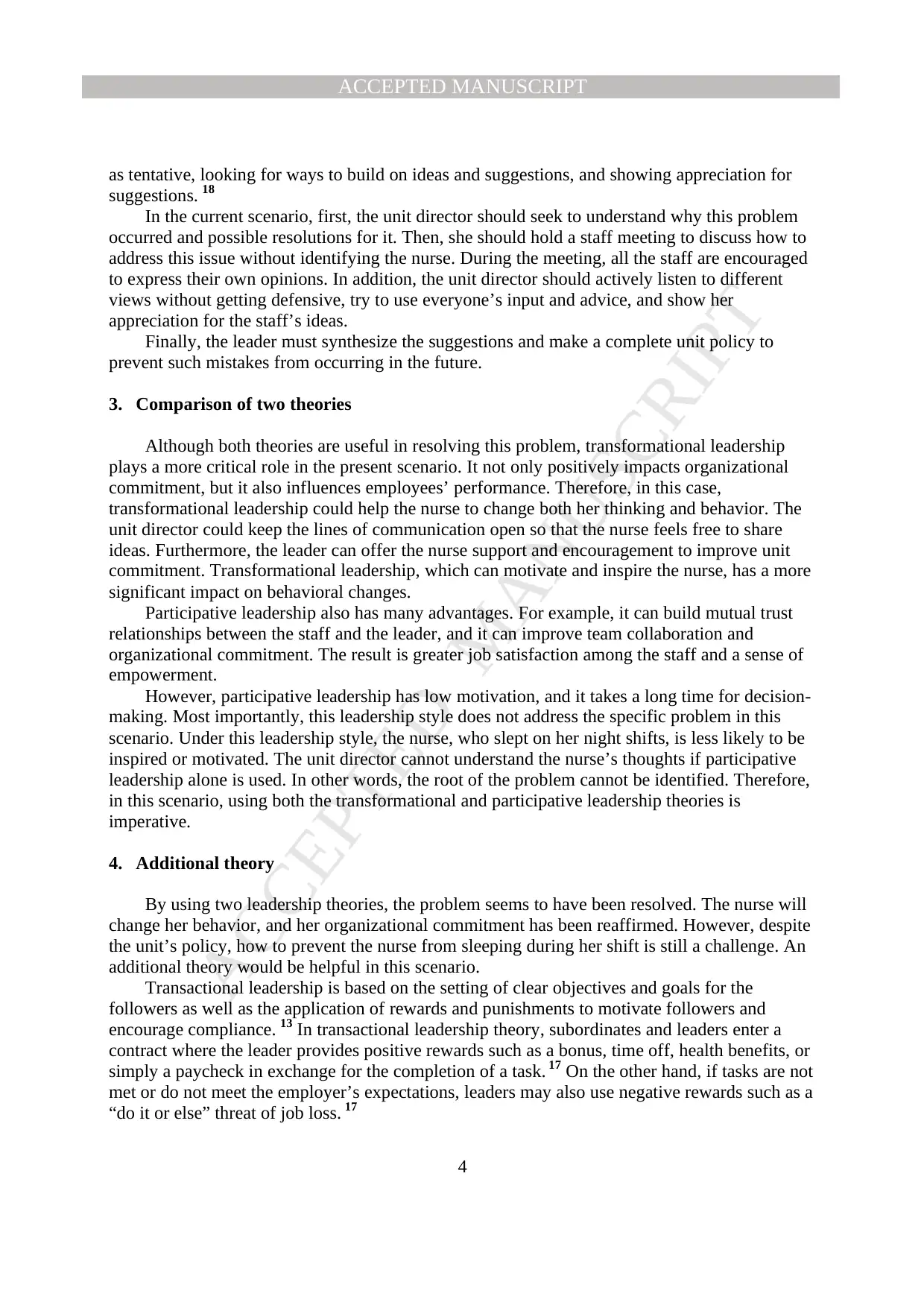
MANUSCRIPTACCEPTED
ACCEPTED MANUSCRIPT
4
as tentative, looking for ways to build on ideas and suggestions, and showing appreciation for
suggestions. 18
In the current scenario, first, the unit director should seek to understand why this problem
occurred and possible resolutions for it. Then, she should hold a staff meeting to discuss how to
address this issue without identifying the nurse. During the meeting, all the staff are encouraged
to express their own opinions. In addition, the unit director should actively listen to different
views without getting defensive, try to use everyone’s input and advice, and show her
appreciation for the staff’s ideas.
Finally, the leader must synthesize the suggestions and make a complete unit policy to
prevent such mistakes from occurring in the future.
3. Comparison of two theories
Although both theories are useful in resolving this problem, transformational leadership
plays a more critical role in the present scenario. It not only positively impacts organizational
commitment, but it also influences employees’ performance. Therefore, in this case,
transformational leadership could help the nurse to change both her thinking and behavior. The
unit director could keep the lines of communication open so that the nurse feels free to share
ideas. Furthermore, the leader can offer the nurse support and encouragement to improve unit
commitment. Transformational leadership, which can motivate and inspire the nurse, has a more
significant impact on behavioral changes.
Participative leadership also has many advantages. For example, it can build mutual trust
relationships between the staff and the leader, and it can improve team collaboration and
organizational commitment. The result is greater job satisfaction among the staff and a sense of
empowerment.
However, participative leadership has low motivation, and it takes a long time for decision-
making. Most importantly, this leadership style does not address the specific problem in this
scenario. Under this leadership style, the nurse, who slept on her night shifts, is less likely to be
inspired or motivated. The unit director cannot understand the nurse’s thoughts if participative
leadership alone is used. In other words, the root of the problem cannot be identified. Therefore,
in this scenario, using both the transformational and participative leadership theories is
imperative.
4. Additional theory
By using two leadership theories, the problem seems to have been resolved. The nurse will
change her behavior, and her organizational commitment has been reaffirmed. However, despite
the unit’s policy, how to prevent the nurse from sleeping during her shift is still a challenge. An
additional theory would be helpful in this scenario.
Transactional leadership is based on the setting of clear objectives and goals for the
followers as well as the application of rewards and punishments to motivate followers and
encourage compliance. 13 In transactional leadership theory, subordinates and leaders enter a
contract where the leader provides positive rewards such as a bonus, time off, health benefits, or
simply a paycheck in exchange for the completion of a task. 17 On the other hand, if tasks are not
met or do not meet the employer’s expectations, leaders may also use negative rewards such as a
“do it or else” threat of job loss. 17
ACCEPTED MANUSCRIPT
4
as tentative, looking for ways to build on ideas and suggestions, and showing appreciation for
suggestions. 18
In the current scenario, first, the unit director should seek to understand why this problem
occurred and possible resolutions for it. Then, she should hold a staff meeting to discuss how to
address this issue without identifying the nurse. During the meeting, all the staff are encouraged
to express their own opinions. In addition, the unit director should actively listen to different
views without getting defensive, try to use everyone’s input and advice, and show her
appreciation for the staff’s ideas.
Finally, the leader must synthesize the suggestions and make a complete unit policy to
prevent such mistakes from occurring in the future.
3. Comparison of two theories
Although both theories are useful in resolving this problem, transformational leadership
plays a more critical role in the present scenario. It not only positively impacts organizational
commitment, but it also influences employees’ performance. Therefore, in this case,
transformational leadership could help the nurse to change both her thinking and behavior. The
unit director could keep the lines of communication open so that the nurse feels free to share
ideas. Furthermore, the leader can offer the nurse support and encouragement to improve unit
commitment. Transformational leadership, which can motivate and inspire the nurse, has a more
significant impact on behavioral changes.
Participative leadership also has many advantages. For example, it can build mutual trust
relationships between the staff and the leader, and it can improve team collaboration and
organizational commitment. The result is greater job satisfaction among the staff and a sense of
empowerment.
However, participative leadership has low motivation, and it takes a long time for decision-
making. Most importantly, this leadership style does not address the specific problem in this
scenario. Under this leadership style, the nurse, who slept on her night shifts, is less likely to be
inspired or motivated. The unit director cannot understand the nurse’s thoughts if participative
leadership alone is used. In other words, the root of the problem cannot be identified. Therefore,
in this scenario, using both the transformational and participative leadership theories is
imperative.
4. Additional theory
By using two leadership theories, the problem seems to have been resolved. The nurse will
change her behavior, and her organizational commitment has been reaffirmed. However, despite
the unit’s policy, how to prevent the nurse from sleeping during her shift is still a challenge. An
additional theory would be helpful in this scenario.
Transactional leadership is based on the setting of clear objectives and goals for the
followers as well as the application of rewards and punishments to motivate followers and
encourage compliance. 13 In transactional leadership theory, subordinates and leaders enter a
contract where the leader provides positive rewards such as a bonus, time off, health benefits, or
simply a paycheck in exchange for the completion of a task. 17 On the other hand, if tasks are not
met or do not meet the employer’s expectations, leaders may also use negative rewards such as a
“do it or else” threat of job loss. 17
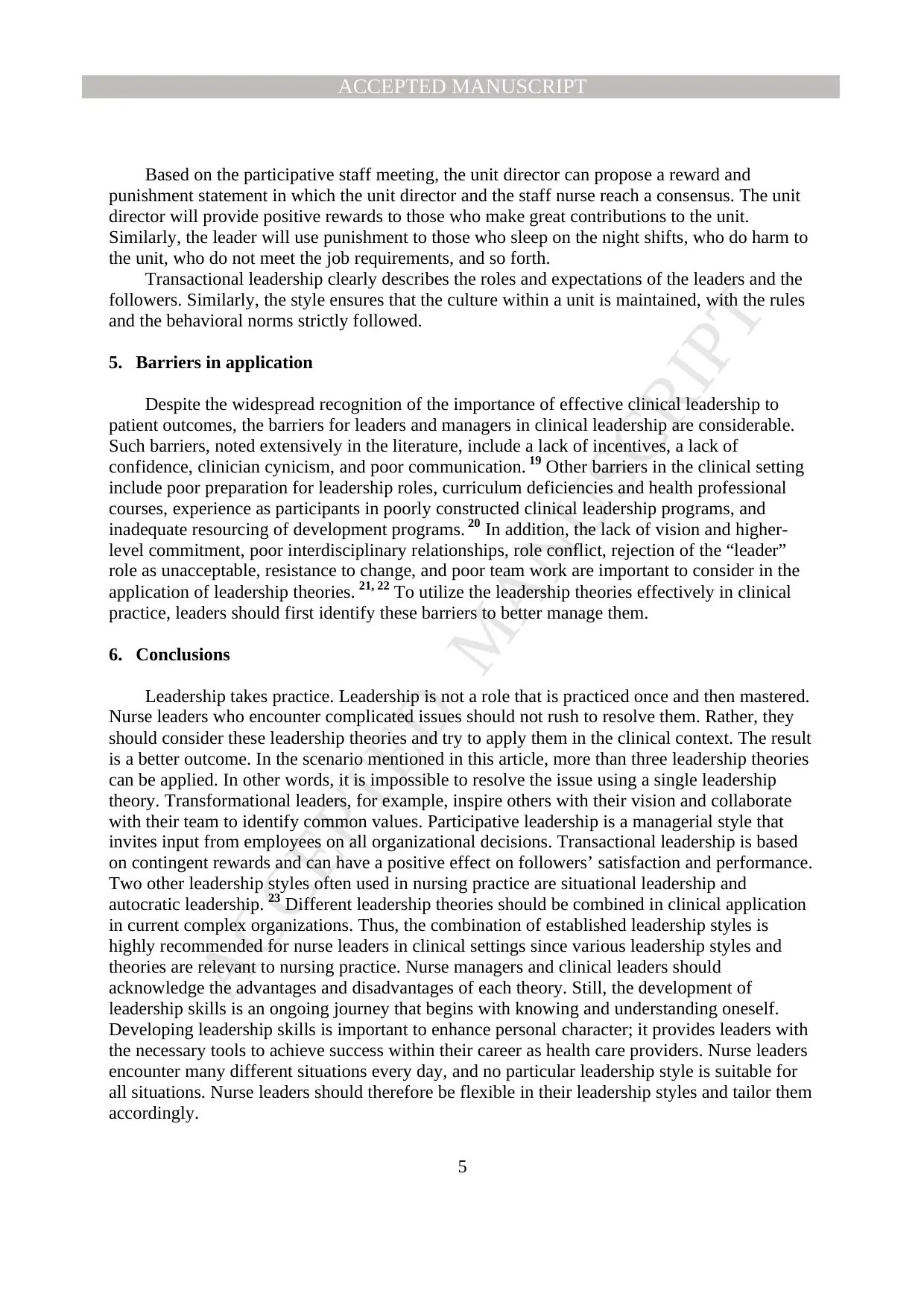
MANUSCRIPTACCEPTED
ACCEPTED MANUSCRIPT
5
Based on the participative staff meeting, the unit director can propose a reward and
punishment statement in which the unit director and the staff nurse reach a consensus. The unit
director will provide positive rewards to those who make great contributions to the unit.
Similarly, the leader will use punishment to those who sleep on the night shifts, who do harm to
the unit, who do not meet the job requirements, and so forth.
Transactional leadership clearly describes the roles and expectations of the leaders and the
followers. Similarly, the style ensures that the culture within a unit is maintained, with the rules
and the behavioral norms strictly followed.
5. Barriers in application
Despite the widespread recognition of the importance of effective clinical leadership to
patient outcomes, the barriers for leaders and managers in clinical leadership are considerable.
Such barriers, noted extensively in the literature, include a lack of incentives, a lack of
confidence, clinician cynicism, and poor communication. 19 Other barriers in the clinical setting
include poor preparation for leadership roles, curriculum deficiencies and health professional
courses, experience as participants in poorly constructed clinical leadership programs, and
inadequate resourcing of development programs. 20 In addition, the lack of vision and higher-
level commitment, poor interdisciplinary relationships, role conflict, rejection of the “leader”
role as unacceptable, resistance to change, and poor team work are important to consider in the
application of leadership theories. 21, 22 To utilize the leadership theories effectively in clinical
practice, leaders should first identify these barriers to better manage them.
6. Conclusions
Leadership takes practice. Leadership is not a role that is practiced once and then mastered.
Nurse leaders who encounter complicated issues should not rush to resolve them. Rather, they
should consider these leadership theories and try to apply them in the clinical context. The result
is a better outcome. In the scenario mentioned in this article, more than three leadership theories
can be applied. In other words, it is impossible to resolve the issue using a single leadership
theory. Transformational leaders, for example, inspire others with their vision and collaborate
with their team to identify common values. Participative leadership is a managerial style that
invites input from employees on all organizational decisions. Transactional leadership is based
on contingent rewards and can have a positive effect on followers’ satisfaction and performance.
Two other leadership styles often used in nursing practice are situational leadership and
autocratic leadership. 23 Different leadership theories should be combined in clinical application
in current complex organizations. Thus, the combination of established leadership styles is
highly recommended for nurse leaders in clinical settings since various leadership styles and
theories are relevant to nursing practice. Nurse managers and clinical leaders should
acknowledge the advantages and disadvantages of each theory. Still, the development of
leadership skills is an ongoing journey that begins with knowing and understanding oneself.
Developing leadership skills is important to enhance personal character; it provides leaders with
the necessary tools to achieve success within their career as health care providers. Nurse leaders
encounter many different situations every day, and no particular leadership style is suitable for
all situations. Nurse leaders should therefore be flexible in their leadership styles and tailor them
accordingly.
ACCEPTED MANUSCRIPT
5
Based on the participative staff meeting, the unit director can propose a reward and
punishment statement in which the unit director and the staff nurse reach a consensus. The unit
director will provide positive rewards to those who make great contributions to the unit.
Similarly, the leader will use punishment to those who sleep on the night shifts, who do harm to
the unit, who do not meet the job requirements, and so forth.
Transactional leadership clearly describes the roles and expectations of the leaders and the
followers. Similarly, the style ensures that the culture within a unit is maintained, with the rules
and the behavioral norms strictly followed.
5. Barriers in application
Despite the widespread recognition of the importance of effective clinical leadership to
patient outcomes, the barriers for leaders and managers in clinical leadership are considerable.
Such barriers, noted extensively in the literature, include a lack of incentives, a lack of
confidence, clinician cynicism, and poor communication. 19 Other barriers in the clinical setting
include poor preparation for leadership roles, curriculum deficiencies and health professional
courses, experience as participants in poorly constructed clinical leadership programs, and
inadequate resourcing of development programs. 20 In addition, the lack of vision and higher-
level commitment, poor interdisciplinary relationships, role conflict, rejection of the “leader”
role as unacceptable, resistance to change, and poor team work are important to consider in the
application of leadership theories. 21, 22 To utilize the leadership theories effectively in clinical
practice, leaders should first identify these barriers to better manage them.
6. Conclusions
Leadership takes practice. Leadership is not a role that is practiced once and then mastered.
Nurse leaders who encounter complicated issues should not rush to resolve them. Rather, they
should consider these leadership theories and try to apply them in the clinical context. The result
is a better outcome. In the scenario mentioned in this article, more than three leadership theories
can be applied. In other words, it is impossible to resolve the issue using a single leadership
theory. Transformational leaders, for example, inspire others with their vision and collaborate
with their team to identify common values. Participative leadership is a managerial style that
invites input from employees on all organizational decisions. Transactional leadership is based
on contingent rewards and can have a positive effect on followers’ satisfaction and performance.
Two other leadership styles often used in nursing practice are situational leadership and
autocratic leadership. 23 Different leadership theories should be combined in clinical application
in current complex organizations. Thus, the combination of established leadership styles is
highly recommended for nurse leaders in clinical settings since various leadership styles and
theories are relevant to nursing practice. Nurse managers and clinical leaders should
acknowledge the advantages and disadvantages of each theory. Still, the development of
leadership skills is an ongoing journey that begins with knowing and understanding oneself.
Developing leadership skills is important to enhance personal character; it provides leaders with
the necessary tools to achieve success within their career as health care providers. Nurse leaders
encounter many different situations every day, and no particular leadership style is suitable for
all situations. Nurse leaders should therefore be flexible in their leadership styles and tailor them
accordingly.
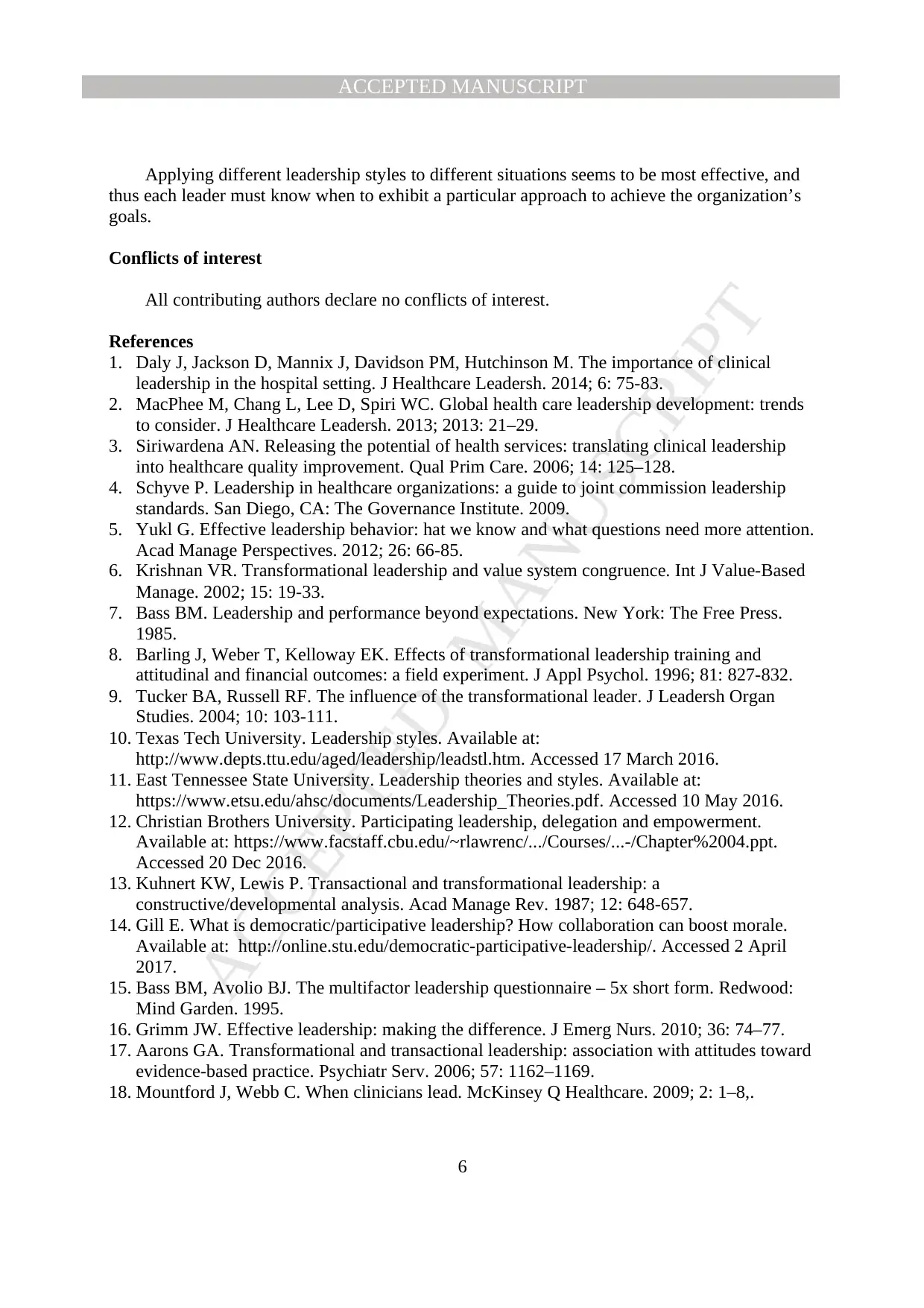
MANUSCRIPTACCEPTED
ACCEPTED MANUSCRIPT
6
Applying different leadership styles to different situations seems to be most effective, and
thus each leader must know when to exhibit a particular approach to achieve the organization’s
goals.
Conflicts of interest
All contributing authors declare no conflicts of interest.
References
1. Daly J, Jackson D, Mannix J, Davidson PM, Hutchinson M. The importance of clinical
leadership in the hospital setting. J Healthcare Leadersh. 2014; 6: 75-83.
2. MacPhee M, Chang L, Lee D, Spiri WC. Global health care leadership development: trends
to consider. J Healthcare Leadersh. 2013; 2013: 21–29.
3. Siriwardena AN. Releasing the potential of health services: translating clinical leadership
into healthcare quality improvement. Qual Prim Care. 2006; 14: 125–128.
4. Schyve P. Leadership in healthcare organizations: a guide to joint commission leadership
standards. San Diego, CA: The Governance Institute. 2009.
5. Yukl G. Effective leadership behavior: hat we know and what questions need more attention.
Acad Manage Perspectives. 2012; 26: 66-85.
6. Krishnan VR. Transformational leadership and value system congruence. Int J Value-Based
Manage. 2002; 15: 19-33.
7. Bass BM. Leadership and performance beyond expectations. New York: The Free Press.
1985.
8. Barling J, Weber T, Kelloway EK. Effects of transformational leadership training and
attitudinal and financial outcomes: a field experiment. J Appl Psychol. 1996; 81: 827-832.
9. Tucker BA, Russell RF. The influence of the transformational leader. J Leadersh Organ
Studies. 2004; 10: 103-111.
10. Texas Tech University. Leadership styles. Available at:
http://www.depts.ttu.edu/aged/leadership/leadstl.htm. Accessed 17 March 2016.
11. East Tennessee State University. Leadership theories and styles. Available at:
https://www.etsu.edu/ahsc/documents/Leadership_Theories.pdf. Accessed 10 May 2016.
12. Christian Brothers University. Participating leadership, delegation and empowerment.
Available at: https://www.facstaff.cbu.edu/~rlawrenc/.../Courses/...-/Chapter%2004.ppt.
Accessed 20 Dec 2016.
13. Kuhnert KW, Lewis P. Transactional and transformational leadership: a
constructive/developmental analysis. Acad Manage Rev. 1987; 12: 648-657.
14. Gill E. What is democratic/participative leadership? How collaboration can boost morale.
Available at: http://online.stu.edu/democratic-participative-leadership/. Accessed 2 April
2017.
15. Bass BM, Avolio BJ. The multifactor leadership questionnaire – 5x short form. Redwood:
Mind Garden. 1995.
16. Grimm JW. Effective leadership: making the difference. J Emerg Nurs. 2010; 36: 74–77.
17. Aarons GA. Transformational and transactional leadership: association with attitudes toward
evidence-based practice. Psychiatr Serv. 2006; 57: 1162–1169.
18. Mountford J, Webb C. When clinicians lead. McKinsey Q Healthcare. 2009; 2: 1–8,.
ACCEPTED MANUSCRIPT
6
Applying different leadership styles to different situations seems to be most effective, and
thus each leader must know when to exhibit a particular approach to achieve the organization’s
goals.
Conflicts of interest
All contributing authors declare no conflicts of interest.
References
1. Daly J, Jackson D, Mannix J, Davidson PM, Hutchinson M. The importance of clinical
leadership in the hospital setting. J Healthcare Leadersh. 2014; 6: 75-83.
2. MacPhee M, Chang L, Lee D, Spiri WC. Global health care leadership development: trends
to consider. J Healthcare Leadersh. 2013; 2013: 21–29.
3. Siriwardena AN. Releasing the potential of health services: translating clinical leadership
into healthcare quality improvement. Qual Prim Care. 2006; 14: 125–128.
4. Schyve P. Leadership in healthcare organizations: a guide to joint commission leadership
standards. San Diego, CA: The Governance Institute. 2009.
5. Yukl G. Effective leadership behavior: hat we know and what questions need more attention.
Acad Manage Perspectives. 2012; 26: 66-85.
6. Krishnan VR. Transformational leadership and value system congruence. Int J Value-Based
Manage. 2002; 15: 19-33.
7. Bass BM. Leadership and performance beyond expectations. New York: The Free Press.
1985.
8. Barling J, Weber T, Kelloway EK. Effects of transformational leadership training and
attitudinal and financial outcomes: a field experiment. J Appl Psychol. 1996; 81: 827-832.
9. Tucker BA, Russell RF. The influence of the transformational leader. J Leadersh Organ
Studies. 2004; 10: 103-111.
10. Texas Tech University. Leadership styles. Available at:
http://www.depts.ttu.edu/aged/leadership/leadstl.htm. Accessed 17 March 2016.
11. East Tennessee State University. Leadership theories and styles. Available at:
https://www.etsu.edu/ahsc/documents/Leadership_Theories.pdf. Accessed 10 May 2016.
12. Christian Brothers University. Participating leadership, delegation and empowerment.
Available at: https://www.facstaff.cbu.edu/~rlawrenc/.../Courses/...-/Chapter%2004.ppt.
Accessed 20 Dec 2016.
13. Kuhnert KW, Lewis P. Transactional and transformational leadership: a
constructive/developmental analysis. Acad Manage Rev. 1987; 12: 648-657.
14. Gill E. What is democratic/participative leadership? How collaboration can boost morale.
Available at: http://online.stu.edu/democratic-participative-leadership/. Accessed 2 April
2017.
15. Bass BM, Avolio BJ. The multifactor leadership questionnaire – 5x short form. Redwood:
Mind Garden. 1995.
16. Grimm JW. Effective leadership: making the difference. J Emerg Nurs. 2010; 36: 74–77.
17. Aarons GA. Transformational and transactional leadership: association with attitudes toward
evidence-based practice. Psychiatr Serv. 2006; 57: 1162–1169.
18. Mountford J, Webb C. When clinicians lead. McKinsey Q Healthcare. 2009; 2: 1–8,.
Paraphrase This Document
Need a fresh take? Get an instant paraphrase of this document with our AI Paraphraser
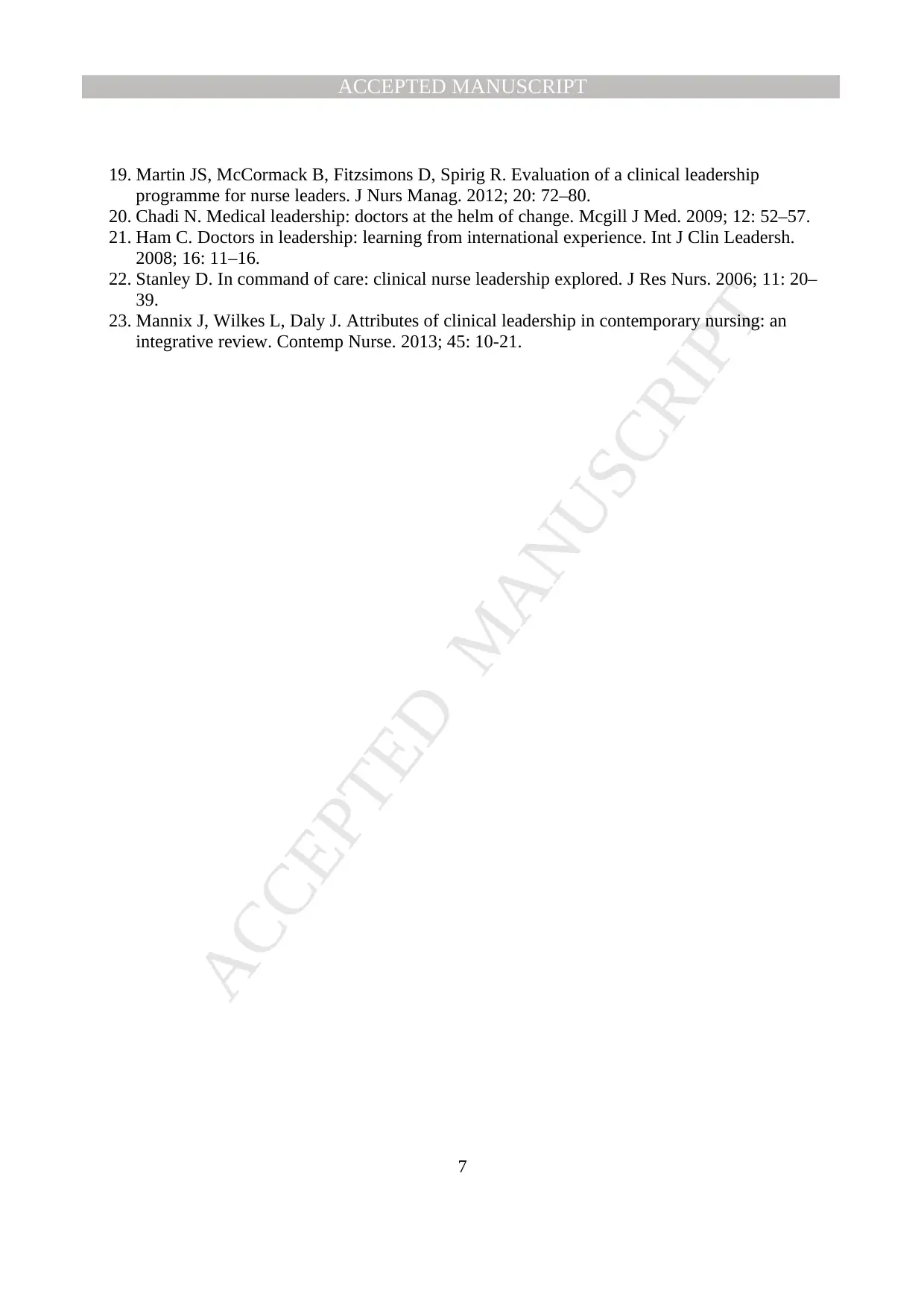
MANUSCRIPTACCEPTED
ACCEPTED MANUSCRIPT
7
19. Martin JS, McCormack B, Fitzsimons D, Spirig R. Evaluation of a clinical leadership
programme for nurse leaders. J Nurs Manag. 2012; 20: 72–80.
20. Chadi N. Medical leadership: doctors at the helm of change. Mcgill J Med. 2009; 12: 52–57.
21. Ham C. Doctors in leadership: learning from international experience. Int J Clin Leadersh.
2008; 16: 11–16.
22. Stanley D. In command of care: clinical nurse leadership explored. J Res Nurs. 2006; 11: 20–
39.
23. Mannix J, Wilkes L, Daly J. Attributes of clinical leadership in contemporary nursing: an
integrative review. Contemp Nurse. 2013; 45: 10-21.
ACCEPTED MANUSCRIPT
7
19. Martin JS, McCormack B, Fitzsimons D, Spirig R. Evaluation of a clinical leadership
programme for nurse leaders. J Nurs Manag. 2012; 20: 72–80.
20. Chadi N. Medical leadership: doctors at the helm of change. Mcgill J Med. 2009; 12: 52–57.
21. Ham C. Doctors in leadership: learning from international experience. Int J Clin Leadersh.
2008; 16: 11–16.
22. Stanley D. In command of care: clinical nurse leadership explored. J Res Nurs. 2006; 11: 20–
39.
23. Mannix J, Wilkes L, Daly J. Attributes of clinical leadership in contemporary nursing: an
integrative review. Contemp Nurse. 2013; 45: 10-21.
1 out of 8
Your All-in-One AI-Powered Toolkit for Academic Success.
+13062052269
info@desklib.com
Available 24*7 on WhatsApp / Email
![[object Object]](/_next/static/media/star-bottom.7253800d.svg)
Unlock your academic potential
© 2024 | Zucol Services PVT LTD | All rights reserved.

